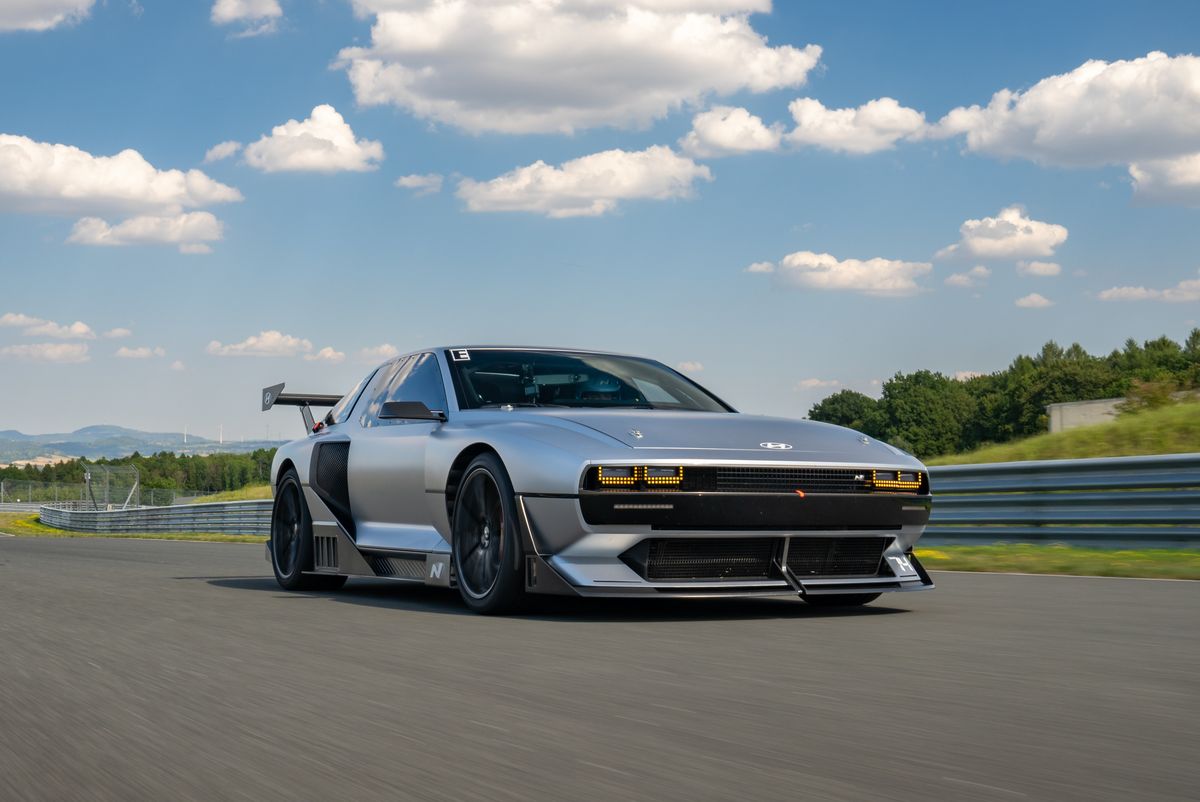Few of us who grew up in the ’80s—or any other decade—would disagree with Dr. Emmett Brown’s introduction of the DeLorean DMC-12 in Back to the Future: “The way I see it, if you’re going to build a time machine into a car, why not do it with some style?”
Now we know that the same principle holds true for future-looking hydrogen fuel-cell demonstrators. Hyundai’s N Vision 74 “rolling lab” doesn’t just bear a passing resemblance to the stance and proportions of the DeLorean, it actually has a genuine, if distant, connection to the stainless-steel sports car.
This hydrogen-fuel-cell/electric hybrid sports-car concept set the automotive internet alight when it was first shown a couple of months ago. The N Vision 74 demonstrated Hyundai’s continued commitment to hydrogen power through the combination of a 670-hp powertrain and what those early images suggested was the ability to generate impressive drift angles. Now we’ve had the chance to drive an engineering prototype, and we can confirm that the N Vision 74 has both superstar presence in the flesh and the ability to smoke its rear tires. This is the sort of future we can all get behind.
Sadly, there are no plans to put the N Vision 74 into production—the drivable version was created mostly to help Hyundai learn more about what the company calls a “virtual differential”—two separate 335-hp motors with no physical connection between them power its rear wheels. Nor, it turns out, is the engineering car actually a Hyundai underneath.
“It’s a [Kia] Stinger,” Albert Biermann tells C/D with a broad grin. The 66-year-old German left BMW’s M Division to become Hyundai-Kia’s R&D boss and also founded Hyundai’s N Division. Although he’s now retired from that job, he still works for the group under the far-ranging job description of executive technical advisor. It’s a role that, clearly, gives him the ability to make PR executives squirm as he heads off the official script. “The design came much later, and the whole idea started off with a different brand, it wasn’t an N thing at all, it was for the luxury brand [Genesis]. But then we said, ‘This is a lot of complicated stuff,’ so we had to build a mecha-proto—which is what we call a prototype built on an existing car—and then apply the new systems. We realized the Stinger was closest in terms of size.”
Four of these Stinger-based prototypes were built, each with the 85-kW fuel-cell stack from the existing Hyundai Nexo in addition to a high-performance 62.4-kWh battery pack. As 85 kilowatts translates into 114 horsepower, those numbers make clear that the hydrogen stack isn’t directly providing the power required by the high-output motors; rather, it is acting as an on-board charger to extend range. Hyundai quotes a figure of about 370 miles from the combination of a fully recharged battery pack and the 9.3 pounds of hydrogen the twin rear tanks can store.
The decision to turn one of the prototypes into the N Vision 74 came later, and the concept’s bodywork involves a deep dive into Hyundai’s earliest history. Lee SangYup, executive vice president of design, led the project. He’s a man with plenty of experience when it comes to styling muscular coupes. Before joining Hyundai, he was responsible for both the 2010 Chevrolet Camaro and the gorgeous Bentley EXP 10 Speed 6 concept from 2015. As its name suggests, the N Vision 74 takes its inspiration from the 1970s, when Hyundai commissioned Giorgetto Giugiaro to create a coupe version of the company’s first independently produced car, the Pony hatchback. The result had much of the wedgy form common to his more famous designs from the same era—but probably the closest resemblance to the Alfa Romeo Alfasud Sprint and the 1970 Porsche Tapiro concept.
The Pony Coupe didn’t make production. The fledgling company had more urgent needs than a halo coupe and, as Lee admits, “We didn’t have an engine or suspension that could match the design.” The project was dropped, but the original tooling blueprints stayed in the company archives—and Giugiaro used them as the starting point for what became the DeLorean DMC-12, albeit with the addition of gullwing doors. And although officially inspired by the Pony Coupe, there is something unarguably DeLorean-ish about the N Vision 74’s profile and the dark fascia bar where the pixel headlamps are located. Lee has one request, though: that we don’t call it the “Seventy-four.” “It sounds much better in Korean: Chilsib Sa,” he says.



